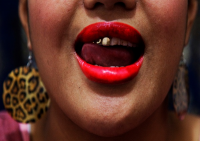
We Do This
Audrey Baldwin
Christchurch Art Gallery Te Puna o Waiwhetū
12 May 2018 – 26 May 2019
We Do This showcases a wide range of works by women and non-binary artists from around the country. Curated by Felicity Milburn and Lara Strongman in the context of Aotearoa’s 125th of universal suffrage, it’s a refreshing collection of works which packs a punch; visually, conceptually and historically. With over 30 works in the show, I’ll touch on my personal highlights.
We Do This (1988), Alexis Hunter’s large canvas is filled to the brim. Aggressively daubed leopard print, a spray of blood, empty eyes and layers of animal pelts like gestural spectres - a pile of skins waiting to be burnt, holding the viewer accountable for the actions of the invisible poachers.
The title of the exhibition takes on a different meaning with Hunter’s ecological commentary. It prevents it from just being a feel-good pat-on-the-back show and offers an invitation to reflect and change what ‘we’ do. The te reo title of the show - Nei Te Mahi - loosely translates as ‘here’s the work’/the process, which puts me in mind of labour already undertaken and still to come. It speaks of process, as opposed to a clean-cut end result.
Process and a discursive approach are evident in Emma Fitts’ fabric works, which gently assert themselves in space. Her series of fabric assemblages, including Blouse and Trousers for Olivia Spencer Bower (2014) deftly reintegrate the body, while riffing on traditions of abstract modernism. They re-centre and remember influential women in history. The painterly pieces hang like architectural drawings, abstract garments or perhaps silk battle banners.
Intergenerational conversations and reflections abound in the exhibition. A particular work that celebrates cultural legacies, layers of memory and identity is Ane Tonga’s photograph of a woman with traditional Tongan nifo koula. The metallic print is close cropped, framing a larger-than-life mouth rocking a bold red lip-stick smile - tongue tip to gold tooth. The smile in Seta (2012) is one of knowing and being known. It is of occupying space unapologetically and inviting others to do the same.
Robyn Kahukiwa’s iconic Tena I Ruia (1987) is a particularly powerful piece. The painting depicts Ngāti Porou women performing their haka. These mana wahine are literally and figuratively standing together, defiant in the face of the patriarchy (another effect of colonisation), asserting and affirming the importance of tangata whenua. The unflinching gaze of the figures convey a sense of unity and determination. With its expressionist brush strokes in vivid reds and purples creating layers of movement; it positively thrums with energy.
We Do This promises to be electrifying and it delivers. The show manages to be diverse and critically engaged, yet ready to laugh. Perhaps more importantly, it offers launching pads for conversation whether you’re a seasoned academic or just want to see a collection of wonderful pieces.
We Do This
Until 26 May 2019
Christchurch Art Gallery Te Puna o Waiwhetū
Cnr Worcester Boulevard and Montreal Street
Images
Robyn Kahukiwa Tena I Ruia 1987. Acrylic on canvas. Collection of Christchurch Art Gallery Te Puna o Waiwhetū, purchased 1989
Ane Tonga Seta 2012. Metallic print on 4mm aluminium dibond. Collection of Christchurch Art Gallery Te Puna o Waiwhetū, gift of the Friends of Christchurch Art Gallery, 2017
